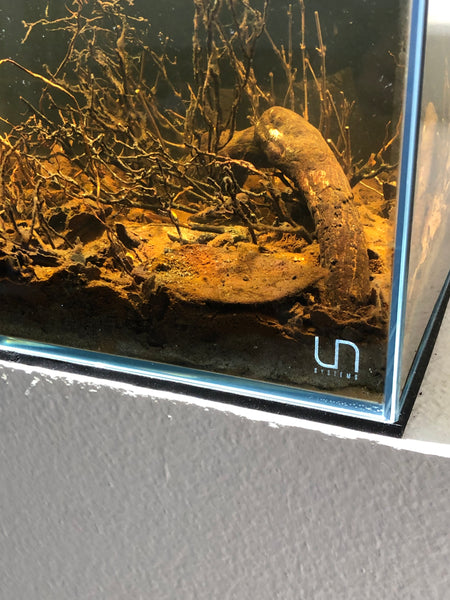- Continue Shopping
- Your Cart is Empty
Piling up
As you know, we're pretty into substrates around here!
And not just sand and gravel, as we've discussed repeatedly. Now, here's the thing: I am 100% certain that you can use all sorts of materials to create a functional and useful substrate for your aquarium. I've done this for many years with great success, as many of you have.

Long term management of our botanical-style aquariums has evolved along with the mindsets which accompany them. And this extends to how we treat our existing aquarium when we "remodel" it.
Especially the substrate.

I think we need to stop "ditching" our "old"substrates when we iterate our tanks.
I know, the idea of leaving the substrate and leaf litter/botanical "bed" intact as you "remodel" isn't exactly a crazy one. And conceptually, it's sort of replicates what occurs in Nature, doesn't it?

Yeah, think about this for just a second.
As we almost constantly discuss, habitats like flooded forests, meadows, vernal pools, igarape, and swollen streams tend to encompass terrestrial habitats, or go through phases where they are terrestrial habitats for a good part of the year.
In these wild habitats, the leaves, branches, soils, and other botanical materials remain in place, or are added to by dynamic, seasonal processes. For the most part, the soil, branches, and a fair amount of the more "durable" seed pods and such remain present during both phases.
Beyond simply replicating these inundation/dry season cycles (ie; the "Urban Igapo" thing again), think about how materials, including detritus, accumulate in the substrate, and what the impact of removing this stuff is.
When you remove much of the hardscape, plants, etc. from the aquarium as you "evolve" it to something else, yet leave the substrate, some of the hardscape, leaves, etc. intact, you're essentially mimicking this process in a most realistic way.

Sure, a "makeover" of an aquarium can be a seriously disruptive event. On the other hand, if you take the mindset that this is a "transformation" of sorts, and act accordingly, it becomes more of an evolutionary process.
Leaving in the existing botanical substrate, along with its decomposing leaves, bark, sedimented material, detritus, and the accompanying biotia just makes a lot of sense, IMHO.

I mean, if you're not sold on the benefits that the biological continuity of leaving your "old" substrate intact bring, you can likely embrace the idea that decomposing leaves and such comprise a sort of aquatic "mulch" for plant growth, right? Mulch, by definition is: "Material (such as decaying leaves, bark, or compost) spread around or over a plant to enrich or insulate the soil."
What works in the garden likely works in the aquarium, in the context of "substrate enrichment", right?

I think that the possibility of utilizing botanicals along with specialized substrates as a means to grow plants and enrich the overall aquarium ecosystem on many levels is simply too irresistible to overlook. We've talked about this before. Indeed, botanicals are a sort of "substrate" in and of themselves- and that is something that's quite interesting!
Yes, we've talked about this almost constantly for years.
And they are ALIVE.

The idea of considering the substrate of your aquarium a living, breathing organism makes you take a different mindset. I mean, would you essentially kill an entire ecological niche within your tank simply because you want a "do-over" on the hardscape, plants, or other part of the "theme?"

Not if you look at it like that, right?
Just because you were doing a South American-inspired tank, and now you're going African- if the water parameters are intended to basically be the same, what's the point in decimating an entire functioning substrate in the process?
That's not "progress"- that's a huge setback!
The typical justification for ditching the old substrate during a tank "remodel" is that you want to "get rid of all of the detritus that's accumulate in the substrate..."
Wait a minute!
If we really look at it objectively, "detritus" plays a very important role on our systems. It not only provides a physical place for positive biological activity which supports the overall function of the aquarium- it fuels it.

Yup.
With our embrace of "detritus" or "mulm" as a source of "fuel" for creating active biological systems within the confines of our aquariums, I think that the idea of an "enriched substrate" will become an integral part of the overall ecosystems that we create. Considering the substrate as both an aesthetic AND functional component- even in "non-planted" aquariums, opens up a whole new area of aquarium "exploration."
I envision that the future of mainstream aquarium practice may include creating such a substrate as simply part of "what we do." Adding a mix of botanical materials, live bacterial and small organism cultures, and even some "detritus" from healthy aquatic systems may become how we establish systems. And leaving the existing materials alone and building upon them will be the way.
These ideas are cool.

Cool, because they force us to look at Nature in a different way. Cool- because they make us consider not only the "appearance", but the (wait for it...) function of the natural habitats we're fascinated by and the aquariums which we develop to replicate them.
So, it's okay to let things "pile up" now and then, right?
I think so.
Today's simple, but important thought.
Stay curious. Stay brave. Stay motivated. Stay excited...
And Stay Wet.
Scott Fellman
Tannin Aquatics








Scott Fellman
Author